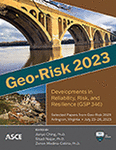Loss Assessment of Dike-Break Induced Flood Disaster: A Case Study in the Poyang Lake District in China
Publication: Geo-Risk 2023
ABSTRACT
Loss evaluation of dike-break-induced flood disaster has become a worldwide concern due to its enormous economic, environmental, and societal importance. In this paper, the Sanjiao dike in the Poyang Lake district in China is investigated as a case study. An integrated dike-break-induced flood modeling and losses assessment framework is proposed. The MIKE 21-based numerical approach is developed to model the flood routing process in the flood protection region of dike. A flood routing model that can take into account the influence of land utilization on the roughness coefficient of underlying surface is established for the Sanjiao dike. By this means, the flood water depth, flow velocity, flood peak appearance time, and other spatiotemporally distributed flood inundation data can be obtained. With the behavior of the flood well understood, a physics-informed quantitative approach is further developed on ArcGIS and Python platform to assess the dike-break-induced flood losses, including life, economic, and ecological environment losses. The research outcomes provide an integrated decision-making process for flood warning and risk mitigation in the protection region of dike.
Get full access to this article
View all available purchase options and get full access to this chapter.
REFERENCES
DHI (Danish Hydraulic Institute). (2007). MIKE 21 flow model: Hydrodynamic module user guide. Danish Hydraulic Institute Water and Environment.
Graham, W. J. (1999). “A procedure for estimating loss of life caused by dam failure.” In: US Bureau of Reclamation, Dam Safety Office, Denver, USA,.
Jiang, S. H., Huang, Z. F., and Huang, J. (2020). “Dike-break induced flood simulation and consequences assessment in flood detention basin.” Zhang, J. et al. (Eds.): ICED 2020: Dam Breach Modelling and Risk Disposal, SSGG. Springer Nature Switzerland AG, pp. 295–310.
Jiang, S. H., Zhi, H. L., Wang, Z. Z., and Zhang, S. (2023). “Enhancing flood risk assessment and mitigation through numerical modelling: a case study.” Nat. Hazards Rev., 24(1): 04022046.
Komolafe, A. A., Herath, S., and Avtar, R. (2019). “Establishment of detailed loss functions for the urban flood risk assessment in Chao Phraya River basin, Thailand.” Geomat. Nat. Haz. Risk, 10(1), 633–650.
Ministry of Water Resources of the People’s Republic of China. (2019). Zhongguo Shuihan Zaihai Gongbao 2019. Gazette of the Ministry of Water Resources of the People's Republic of China. (in Chinese).
Pariartha, G., Goonetilleke, A., Egodawatta, P., and Mirfenderesk, H. (2020). “The prediction of flood damage in coastal urban areas.” IOP Conference Series Earth and Environmental Science, 419, 012136.
Parsapour, M. P., Rennie, C. D., and Slaney, J. (2018). “Hydrodynamic simulation of an irregularly meandering gravel-bed river: comparison of MIKE 21 FM and Delft3D flow models.” E3S Web of Conferences, 40(6), 02004.
Piers, M. (1998). “Methods and models for the assessment of third-party risk due to aircraft accidents in the vicinity of airports and their implications for societal risk.” In: Jorissen RE, Stallen PJM (Eds.). Quantified societal risk and policy making. Dordrecht, Netherlands: Kluwer Academic Publishers.
Pathan, A. I., and Agnihotri, P. G. (2021). “Application of new HEC-RAS version 5 for 1D hydrodynamic flood modeling with special reference through geospatial techniques: a case of River Purna at Navsari, Gujarat, India.” Model. Earth Syst. Env., 7(2), 1133–1144.
Shrestha, A., Bhattacharjee, L., Baral, S., Thakur, B., and Gupta, R. (2020). “Understanding Suitability of MIKE 21 and HEC-RAS for 2D Floodplain Modeling.” World Environmental and Water Resources Congress 2020.
Smith, A., Martin, D., and Cockings, S. (2016). “Spatio-temporal population modelling for enhanced assessment of urban exposure to flood risk.” Applied Spatial Analysis & Policy, 9(2): 145–163.
Symonds, A. M., Vijverberg, T., Post, S., Spek, B. J. V. D., Henrotte, J., and Sokolewicz, M. (2016). “Comparison between MIKE 21 FM, Delft3D and Delft3D FM flow models of western port bay, Australia.” Coastal Engineering Proceedings, (35), 1–12.
Sidek, L. M., Jaafar, A. S., Majid, W. H. A. W. A., Basri, H., Marufuzzaman, M., Fared, M. M., and Moon, W. C. (2021). “High-resolution hydrological-hydraulic modeling of urban floods using InfoWorks ICM.” Sustainability, 13(18), 10259.
Wang, J. (2021). Ecological risk assessment of dam-break flood based on analysis of ecosystem service value. Zhengzhou University, Master thesis. (in Chinese).
Information & Authors
Information
Published In
History
Published online: Jul 20, 2023
ASCE Technical Topics:
- Bodies of water (by type)
- Business management
- Case studies
- Disaster risk management
- Disasters and hazards
- Economic factors
- Engineering fundamentals
- Flood routing
- Floods
- Hydraulic engineering
- Hydraulic properties
- Hydraulic roughness
- Hydraulic structures
- Lakes
- Levees and dikes
- Methodology (by type)
- Practice and Profession
- Research methods (by type)
- Water and water resources
- Water management
Authors
Metrics & Citations
Metrics
Citations
Download citation
If you have the appropriate software installed, you can download article citation data to the citation manager of your choice. Simply select your manager software from the list below and click Download.
